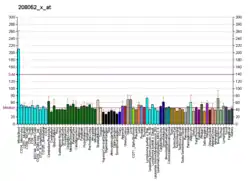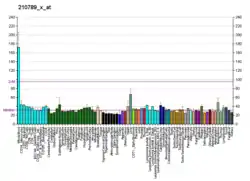CEACAM3
Carcinoembryonic antigen-related cell adhesion molecule 3 (CEACAM3) also known as CD66d (Cluster of Differentiation 66d), is a member of the carcinoembryonic antigen (CEA) gene family..[3]
| CEACAM3 | |||||||||||||||||||||||||
|---|---|---|---|---|---|---|---|---|---|---|---|---|---|---|---|---|---|---|---|---|---|---|---|---|---|
| Identifiers | |||||||||||||||||||||||||
| Aliases | CEACAM3, CD66D, CEA, CGM1, W264, W282, carcinoembryonic antigen related cell adhesion molecule 3, CEA cell adhesion molecule 3 | ||||||||||||||||||||||||
| External IDs | OMIM: 609142 HomoloGene: 130497 GeneCards: CEACAM3 | ||||||||||||||||||||||||
| |||||||||||||||||||||||||
| |||||||||||||||||||||||||
| Orthologs | |||||||||||||||||||||||||
| Species | Human | Mouse | |||||||||||||||||||||||
| Entrez |
| ||||||||||||||||||||||||
| Ensembl |
| ||||||||||||||||||||||||
| UniProt |
| ||||||||||||||||||||||||
| RefSeq (mRNA) |
| ||||||||||||||||||||||||
| RefSeq (protein) |
| ||||||||||||||||||||||||
| Location (UCSC) | Chr 19: 41.8 – 41.81 Mb | n/a | |||||||||||||||||||||||
| PubMed search | [2] | n/a | |||||||||||||||||||||||
| Wikidata | |||||||||||||||||||||||||
| |||||||||||||||||||||||||
This gene encodes a member of the family of carcinoembryonic antigen-related cell adhesion molecules (CEACAMs), which are used by several bacterial pathogens to bind and invade host cells. The encoded transmembrane protein directs phagocytosis of several bacterial species that is dependent on the small GTPase Rac. It is thought to serve an important role in controlling human-specific pathogens by the innate immune system. Alternatively spliced transcript variants have been described, but their biological validity has not been determined.[3]
Use
CEACAM3 is expressed exclusively on granulocytes and used as granulocyte marker.[4]
See also
References
- GRCh38: Ensembl release 89: ENSG00000170956 - Ensembl, May 2017
- "Human PubMed Reference:". National Center for Biotechnology Information, U.S. National Library of Medicine.
- "Entrez Gene: CEACAM3 carcinoembryonic antigen-related cell adhesion molecule 3".
- CEACAM3: an innate immune receptor directed against human-restricted bacterial pathogens. Pils S, Gerrard DT, Meyer A, Hauck CR. Int J Med Microbiol. 2008 Oct;298(7-8):553-60.
Further reading
- Khan WN, Frängsmyr L, Teglund S, et al. (1992). "Identification of three new genes and estimation of the size of the carcinoembryonic antigen family". Genomics. 14 (2): 384–90. doi:10.1016/S0888-7543(05)80230-7. PMID 1427854.
- Kuroki M, Arakawa F, Matsuo Y, et al. (1991). "Molecular cloning of nonspecific cross-reacting antigens in human granulocytes". J. Biol. Chem. 266 (18): 11810–7. PMID 2050678.
- Thompson JA, Mauch EM, Chen FS, et al. (1989). "Analysis of the size of the carcinoembryonic antigen (CEA) gene family: isolation and sequencing of N-terminal domain exons". Biochem. Biophys. Res. Commun. 158 (3): 996–1004. CiteSeerX 10.1.1.657.2780. doi:10.1016/0006-291X(89)92821-0. PMID 2537643.
- Watt SM, Fawcett J, Murdoch SJ, et al. (1994). "CD66 identifies the biliary glycoprotein (BGP) adhesion molecule: cloning, expression, and adhesion functions of the BGPc splice variant". Blood. 84 (1): 200–10. doi:10.1182/blood.V84.1.200.200. PMID 8018919.
- Nagel G, Grunert F, Kuijpers TW, et al. (1993). "Genomic organization, splice variants and expression of CGM1, a CD66-related member of the carcinoembryonic antigen gene family". Eur. J. Biochem. 214 (1): 27–35. doi:10.1111/j.1432-1033.1993.tb17892.x. PMID 8508798.
- Skubitz KM, Campbell KD, Skubitz AP (1996). "CD66a, CD66b, CD66c, and CD66d each independently stimulate neutrophils". J. Leukoc. Biol. 60 (1): 106–17. doi:10.1002/jlb.60.1.106. PMID 8699114. S2CID 46292936.
- Streichert T, Ebrahimnejad A, Ganzer S, et al. (2001). "The microbial receptor CEACAM3 is linked to the calprotectin complex in granulocytes". Biochem. Biophys. Res. Commun. 289 (1): 191–7. doi:10.1006/bbrc.2001.5955. PMID 11708798.
- Skubitz KM, Campbell KD, Skubitz AP (2002). "Synthetic peptides from the N-domains of CEACAMs activate neutrophils". J. Pept. Res. 58 (6): 515–26. doi:10.1034/j.1399-3011.2001.00931.x. PMC 7162001. PMID 12005421.
- Strausberg RL, Feingold EA, Grouse LH, et al. (2003). "Generation and initial analysis of more than 15,000 full-length human and mouse cDNA sequences". Proc. Natl. Acad. Sci. U.S.A. 99 (26): 16899–903. doi:10.1073/pnas.242603899. PMC 139241. PMID 12477932.
- Booth JW, Telio D, Liao EH, et al. (2003). "Phosphatidylinositol 3-kinases in carcinoembryonic antigen-related cellular adhesion molecule-mediated internalization of Neisseria gonorrhoeae". J. Biol. Chem. 278 (16): 14037–45. doi:10.1074/jbc.M211879200. PMID 12571236.
- McCaw SE, Schneider J, Liao EH, et al. (2003). "Immunoreceptor tyrosine-based activation motif phosphorylation during engulfment of Neisseria gonorrhoeae by the neutrophil-restricted CEACAM3 (CD66d) receptor". Mol. Microbiol. 49 (3): 623–37. doi:10.1046/j.1365-2958.2003.03591.x. PMID 12864848. S2CID 12071872.
- Schmitter T, Agerer F, Peterson L, et al. (2004). "Granulocyte CEACAM3 is a phagocytic receptor of the innate immune system that mediates recognition and elimination of human-specific pathogens". J. Exp. Med. 199 (1): 35–46. doi:10.1084/jem.20030204. PMC 1887732. PMID 14707113.
- Kimura K, Wakamatsu A, Suzuki Y, et al. (2006). "Diversification of transcriptional modulation: large-scale identification and characterization of putative alternative promoters of human genes". Genome Res. 16 (1): 55–65. doi:10.1101/gr.4039406. PMC 1356129. PMID 16344560.
- Gimbergues P, Dauplat MM, Cayre A, et al. (2007). "Correlation between molecular metastases in sentinel lymph nodes of breast cancer patients and St Gallen risk category". Eur J Surg Oncol. 33 (1): 16–22. doi:10.1016/j.ejso.2006.09.013. PMID 17071045.
- Gasser M, Gerstlauer C, Grimm M, et al. (2007). "Comparative analysis of predictive biomarkers for therapeutical strategies in colorectal cancer". Ann. Surg. Oncol. 14 (4): 1272–84. doi:10.1245/s10434-006-9155-0. PMID 17211733. S2CID 19408520.
- Howell NR, Zheng W, Cheng L, et al. (2007). "Carcinomas of ovary and lung with clear cell features: can immunohistochemistry help in differential diagnosis?". Int. J. Gynecol. Pathol. 26 (2): 134–40. doi:10.1097/01.pgp.0000233166.56385.d0. PMID 17413979. S2CID 534457.
- Stern-Ginossar N, Nedvetzki S, Markel G, et al. (2007). "Intercellular transfer of carcinoembryonic antigen from tumor cells to NK cells". J. Immunol. 179 (7): 4424–34. doi:10.4049/jimmunol.179.7.4424. PMID 17878338.
External links
- CEACAM3+protein,+human at the US National Library of Medicine Medical Subject Headings (MeSH)
- Human CEACAM3 genome location and CEACAM3 gene details page in the UCSC Genome Browser.
This article incorporates text from the United States National Library of Medicine, which is in the public domain.



